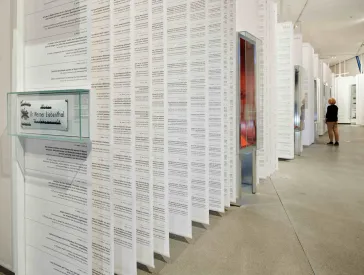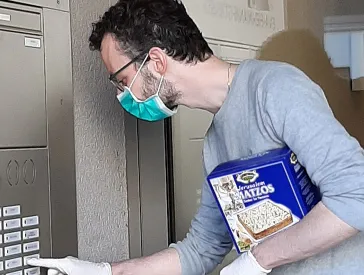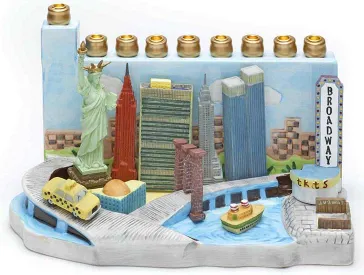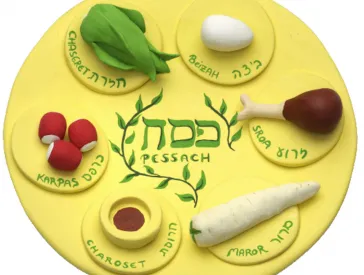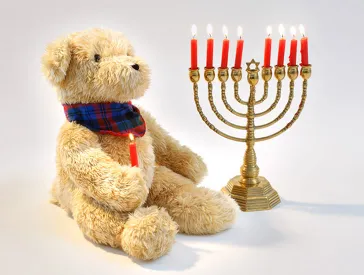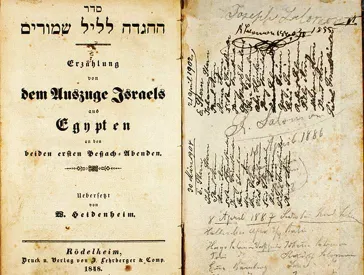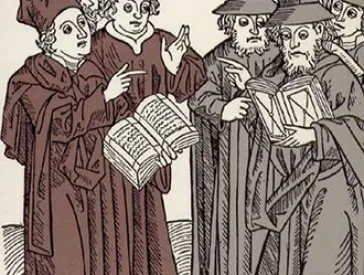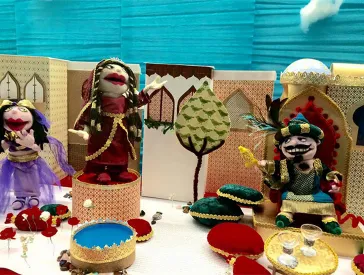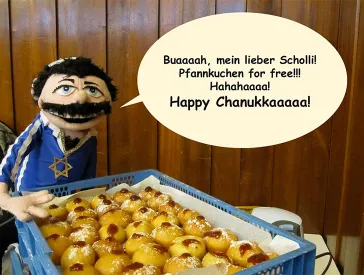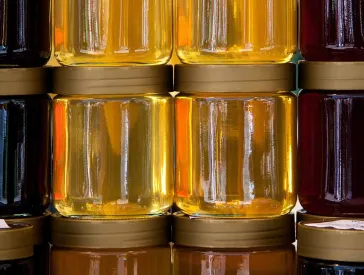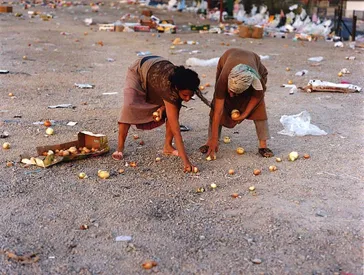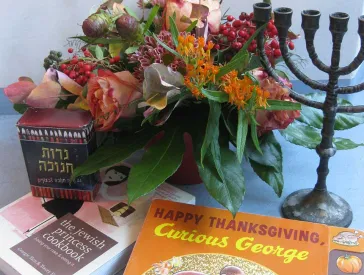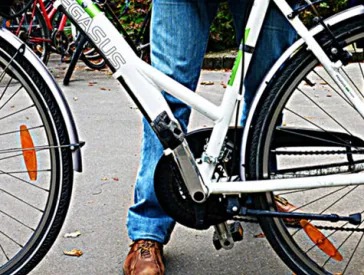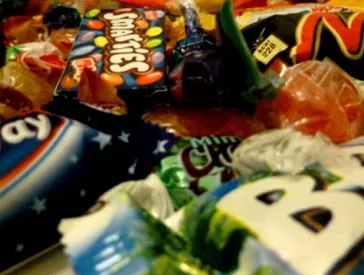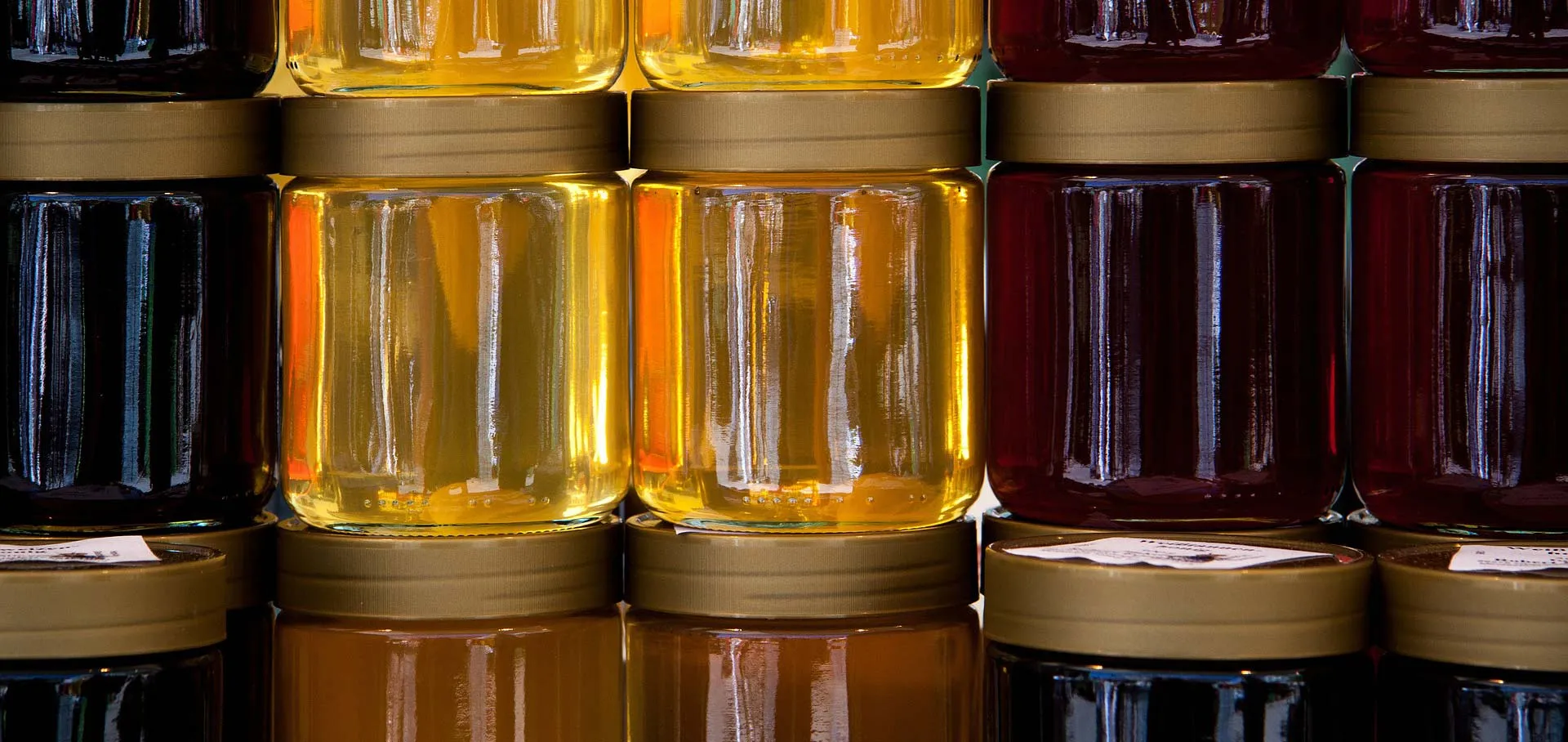
Apples in Honey and Gefilte Fish
How Museum Employees Spend the High Holidays and what they Personally Associate with it
“How are you spending the High Holidays this year?” We posed this question to employees of the Jewish Museum Berlin. Some answered curtly, such as one colleague who “doesn’t usually do anything (aside from dipping a few pieces of apple in honey…).” Others answered indirectly via an out-of-office message which ended with “Cordial greetings and Shanah Tovah.” Here are some additional responses:
How Are You Spending the High Holidays this Year?
“I’m going to go to my grandmother’s for Rosh ha-Shanah, like every year. With one difference: I’m hoping that she will follow my advice this year and forget to warm up the gefilte fish before serving it, because it tastes better cold.” (Alina Gromova, Academic Employee in the Fellowship Program, and Guide)
“Like every year, we observe erev Rosh ha-Shanah at a dinner with friends, which we sanctify by reciting various blessings. We dip apples in honey and buy rare fruit which relinquish their mysteries upon consumption. We celebrate the New Year culinarily, with new, unknown foods to discover, resulting in a kind of biology intelligence test. Unfortunately there are never any kreplach to follow because no one knows how to prepare them anymore, and the gefilte fish comes, if at all, out of a jar. Making it would take days, but worse, cooking fish gives off a smell which fills the entire house, and might drive away the neighbors, and not only the disagreeable ones… The remaining array of dishes is unspectacular. Over the next two days, some of the dinner guests attend synagogue – chosen either out of nostalgia for childhood memories, or out of liturgical interest.” (Cilly Kugelmann, Program Director)
“As on most Jewish holidays, we are not going to do much for Rosh ha-Shanah because my family does not observe religious practice very strictly. Nonetheless, on the evening before the New Year we will eat apples and honey in hope that the next year be full of sweetness. We cherish this tradition – along with many others holiday rituals – as our Jewish heritage.” (Violetta Gershmann-Labunski, Personnel Department)
Honey, source: Pixabay
“I’ll observe the holidays with friends, drinking and dancing – according to my own Tel-Aviv-style tradition.
I also enjoy going to synagogue and praying in a large group. Everyone participates, generating a perfect prayer. But there’s always a discussion about synagogue seat tickets: I have nothing against voluntary donations, but requesting an obligatory gift (in form of yearly seat tickets) to be able to pray seems questionable to me.” (Roland Schmidt, Host)
“I’ll spend the first day of Rosh ha-Shanah this year with my six-year-old son. On the second day though, he’ll have to go to school. On Yom Kippur I sometimes go to synagogue, but not always. I fast in my own way – I don’t eat, but I do drink water.” (Sarah Hiron, Education)
“This year, I’ll spend the High Holidays something like this: at home with my family on the evening of the 4th eating honey cake and watching the movie Ushpizin (2004, it’s actually about Sukkot, but that’s close enough). On the 5th I’ll go to synagogue, though not for too long. By way of exception, the second day of Rosh ha-Shanah will see me entertaining a handful of seven-year-olds, because it collides this year with my daughter’s birthday.” (Naomi Lubrich, Media)
What Memories Do You Associate with the High Holidays?
Franz Rosenthal’s admission ticket for High Holiday services in 1936; Jewish Museum Berlin, accession 2010/44/3, gift of Henri W. Aram, photo: Julia Miszczuk. Further information on this document can be found in our online collections (in German)
“When I think back, I remember first of all friends and family, followed by food – a whole lot of food.” (Roland Schmidt, Host)
“I remember the meals at my grandmother’s as so sumptuous and sprawling that I had the feeling I needed to fast not just on Yom Kippur but for the whole rest of the year.” (Alina Gromova, Academic Employee in the Fellowship Program, and Guide)
“To stay on the culinary topic, I can bring up the days when gefilte fish was still cooked at home. You would order two carp at the fishmonger – who was doing enough business in September to last the entire year, because the customers celebrating Rosh ha-Shanah would stand in line for live fish. You would carry home the floundering content in a metal bucket on the tram, accompanied by the cold glares of ditrustful animal rights activists sitting near you. At home a bathtub filled with water waits for its new inhabitants, who guarantee that personal hygiene of the other residents will be reduced to homeopathic measures for a few days. This unpleasant torture – both for the fish and the people – serves the purpose of desilting the carp. One day before Rosh ha-Shanah, the fish are killed with one purposeful blow to the head, which is covered with a hand-towel. They are then taken out and cooked, while other fish are cooked and minced in a meat grinder. What else must be done with the fish before they become gefilte fish on a plate for Rosh ha-Shanah, garnished with carrot slices on a bed of jelly, I can’t say. Together with the kreplach soup, this food would transport us for two days to another world, away from our everyday life at school, in the city, and even in the country where we lived.” (Cilly Kugelmann, Program Director)
Drawing: Alina Gromova, Jewish Museum Berlin
“The High Holidays call up memories of fancy dresses and new shoes, apples, honey and children’s wine. In the 1980s, I remember playing with my sisters in the courtyard of Pestalozzistr. synagogue when services got dull. During the Wende-years, I attended Berlin’s first joint East-West High Holiday services at Rykestr. synagogue, which people were telling me was a historic event, though I remember finding them no different than usual. In the 1990s, I spent the High Holidays sitting on the floor of the Toronto Jewish Community Center gymnasium, which the egalitarians, who were skeptical of religious decor, converted into a synagogue.” (Naomi Lubrich, Media)
“Above all I remember family reunions in Paris. We would have 20 people seated at the table and my great-aunt Liliane Weinberg cooked the most delicious food. Since she and my great-uncle Marcel died, the family has more or less drifted apart and we only meet sporadically for family celebrations. In Paris we would either walk to the synagogue on the Rue Buffault or to the Grande Synagogue de la Victoire. It only occurs to me in retrospect how lively, young, and dynamic the congregation in Paris is, in comparison with Berlin.” (Sarah Hiron, Education)
What Significance Do the High Holidays Have for You?
Place card with New Year greetings in Hebrew; Jewish Museum Berlin, photo: Jens Ziehe. Further information on this document can be found in our online collections (in German)
“I like Rosh ha-Shanah, and new year festivities in general. I celebrate them all: birthdays, the High Holidays, and December 31st.” (Naomi Lubrich, Media)
“I usually use the time between Rosh ha-Shanah and Yom Kippur to figure out what’s not going so well in my life and what I want to change. I take some time to think about it and take stock.” (Sarah Hiron, Education)
“The High Holidays, like the Sabbath, are a chance to make time for my spiritual faith. For me they are special – holy – days. They encourage me to carry on traditions and become more aware. At the same though, they mean time off, and that means nightlife, having fun, and sleeping in.” (Roland Schmidt, Host)
“Although I live a secular life the rest of the year and don’t go to synagogue, Yom Kippur has a great spiritual significance for me. I fast, turn off music and disregard other forms of entertainment. Instead the day is defined by humility, contemplation, silence, and reflecting on nature. Since it’s not a joyful celebration with one central ritual, Yom Kippur is different every year, so I connect it with new and ever-changing personal experiences.” (Roman Labunski, Education)
The postcard is the only copy of a painting by Moritz Daniel Oppenheim from 1873, which was destroyed in London in 1939; Jewish Museum Berlin, accession 2016/353/0, photo: Jens Ziehe. Further information on this document can be found in our online collections (in German)
Citation recommendation:
JMB employees (2013), Apples in Honey and Gefilte Fish. How Museum Employees Spend the High Holidays and what they Personally Associate with it.
URL: www.jmberlin.de/en/node/6485
Holidays: Old Rituals, New Customs (19)

